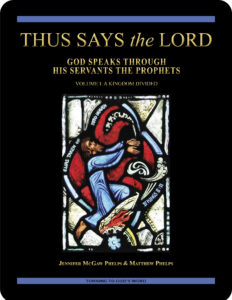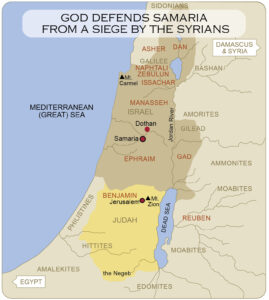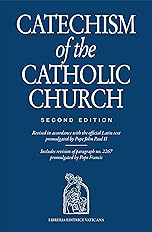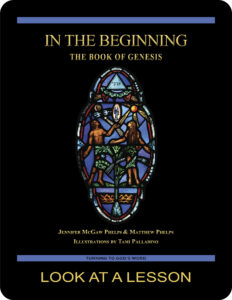 Thus Says the LORD: God Speaks
Thus Says the LORD: God Speaks
Through His Servants the Prophets
Volume I: A Kingdom Divided
Lesson 12 The LORD Thwarts Syrian Attacks
the Second Book of the Kings 6:1—7:20
Revised Standard Version Catholic Edition (RSVCE)*
New American Bible Revised Edition (NABRE)*
Catechism of the Catholic Church
ex libris (in our library)
glossary for Thus Says the LORD—Volume I
cross references in Thus Says the LORD—Volume I
next lesson: Hazael Becomes King of Syria
This material coordinates with Lesson 12 on pages 76–81 in Thus Says the LORD: God Speaks Through His Servants the Prophets—Volume I: A Kingdom Divided.
“Behold, the days are coming, says the LORD, when I will make a new covenant with the house of Israel and the house of Judah, not like the covenant which I made with their fathers when I took them by the hand to bring them out of the land of Egypt, my covenant which they broke, and I showed myself their Master, says the LORD. But this is the covenant which I will make with the house of Israel after those days, says the LORD: I will put my law within them, and I will write it upon their hearts; and I will be their God, and they shall be my people. And no longer shall each man teach his neighbor and each his brother, saying, ‘Know the LORD,’ for they shall all know me, from the least of them to the greatest, says the LORD; for I will forgive their iniquity, and I will remember their sin no more.”—the Book of Jeremiah 31:31–34
welcome to Volume I of our in-depth study of the biblical prophets
We invite you to check out the sample first lesson and video from Volume I of this Turning to  God’s Word
God’s Word  two-part Catholic Bible study. Our online pages link to the free related lesson videos, a glossary, and cross references in the biblical text, and include maps, additional commentary, and prayers based on the primary Scripture in each lesson. Thus Says the LORD: God Speaks Through His Servants the Prophets—Volume I: A Kingdom Divided contains 28 lessons and has been granted an imprimatur. It may be purchased from our website shop. The companion 23-lesson Volume II: Restoration & Redemption also is available for purchase. If you have a Bible-related question or comment, click on the “ask us your question” or “what do you think” button on any study page.
two-part Catholic Bible study. Our online pages link to the free related lesson videos, a glossary, and cross references in the biblical text, and include maps, additional commentary, and prayers based on the primary Scripture in each lesson. Thus Says the LORD: God Speaks Through His Servants the Prophets—Volume I: A Kingdom Divided contains 28 lessons and has been granted an imprimatur. It may be purchased from our website shop. The companion 23-lesson Volume II: Restoration & Redemption also is available for purchase. If you have a Bible-related question or comment, click on the “ask us your question” or “what do you think” button on any study page.
open with prayer
It’s always wise to begin any Bible study with prayer, whether reading the Scriptures alone or meeting with others in a discussion study group. You can pray using your own words or use one of the opening prayers on our website. We especially like the following:
Lord Jesus, you promised to send your Holy Spirit
to teach us all things.
As we read and study your word today,
allow it to touch our hearts and change our lives. Amen.
let’s review—the Second Book of the Kings 4:1—5:27
In Lesson 11 Elisha Performs Miracles, the prophet Elisha demonstrates what it means that he’s received a double portion of Elijah’s spirit. While Elijah’s deeds established that he had been given power by God to wreak havoc—bringing about drought and calling down fire to destroy the LORD’s enemies, Elisha’s miracles show that he’s been given power over life as well as death. Even though both Elisha and Elijah are able to restore life, Elisha is the only person in the Old Testament who apparently is able to bring about life through causing a child to be born. While Elisha’s power clearly comes from God, it’s significant that when the prophet announces that the Shunammite woman is to conceive a son, he does so without even calling upon God. It’s also significant that when the Syrian Naaman is healed of leprosy the text describes this in terms of re-creation, and the event serves as an Old Testament foreshadowing of the sacrament of Baptism. While Elisha relies completely on the LORD for everything, his servant Gehazi fails to do the same. Gehazi’s greed gets the better of him, and as a result he’s stricken with the same leprosy from which the foreigner Naaman had been healed.
map notes—trouble continues between Syria & the northern kingdom
 The action in the sixth and seventh chapters in the Second Book of the Kings takes place in three northern locations—on the bank of the Jordan River and in and around the cities of Dothan and Samaria. It’s notable that the Jordan River also is in the northern kingdom. A freshwater river at its source, the Jordan flows south into the Dead Sea, a body of saltwater that forms the eastern border of the southern kingdom. Dothan, where the Syrian king attempts to corner the prophet Elisha, is in the central region of Israel about 12 miles north of the capital city of Samaria. Click on the map (right) to enlarge it. The original map is on page 79 in Thus Says the LORD: God Speaks Through His Servants the Prophets—Volume I: A Kingdom Divided.
The action in the sixth and seventh chapters in the Second Book of the Kings takes place in three northern locations—on the bank of the Jordan River and in and around the cities of Dothan and Samaria. It’s notable that the Jordan River also is in the northern kingdom. A freshwater river at its source, the Jordan flows south into the Dead Sea, a body of saltwater that forms the eastern border of the southern kingdom. Dothan, where the Syrian king attempts to corner the prophet Elisha, is in the central region of Israel about 12 miles north of the capital city of Samaria. Click on the map (right) to enlarge it. The original map is on page 79 in Thus Says the LORD: God Speaks Through His Servants the Prophets—Volume I: A Kingdom Divided.
 Joram blames the LORD for the trouble in Israel (20:35)
Joram blames the LORD for the trouble in Israel (20:35)
The Second Book of the Kings 6:10 records that Elisha is in the habit of advising  the king of Israel about how to avoid Syrian ambushes. In the Second Book of the Kings 6:30–31, however, the people in Samaria are suffering greatly under siege by the Syrians. Joram’s sympathy for his people appears to be real (he’s wearing sackcloth and he tears his clothing, a sign of mourning), but as Turning to God’s Word author Matthew Phelps explains on the video for this lesson, Joram blames Elisha for the siege and for the ensuing famine. Although Joram intends to have Elisha killed, the king really is blaming God for Israel’s situation. Since it’s impossible to lash out at God, Joram
the king of Israel about how to avoid Syrian ambushes. In the Second Book of the Kings 6:30–31, however, the people in Samaria are suffering greatly under siege by the Syrians. Joram’s sympathy for his people appears to be real (he’s wearing sackcloth and he tears his clothing, a sign of mourning), but as Turning to God’s Word author Matthew Phelps explains on the video for this lesson, Joram blames Elisha for the siege and for the ensuing famine. Although Joram intends to have Elisha killed, the king really is blaming God for Israel’s situation. Since it’s impossible to lash out at God, Joram  instead focuses on God’s spokesman. This all-too-human tendency to blame God for all of our problems often shows up when we feel frustrated by events that we can’t control.
instead focuses on God’s spokesman. This all-too-human tendency to blame God for all of our problems often shows up when we feel frustrated by events that we can’t control.
The Scripture ranges for the videos that accompany this Catholic Bible study match the ranges for the sets of questions in Thus Says the LORD: God Speaks Through His Servants the Prophets—Volume I: A Kingdom Divided. You can follow along with the video as Turning to God’s Word author Matthew Phelps discusses Lesson 12, “The LORD Thwarts Syrian Attacks,” on pages 76–81 in the study book.
the same old question: who’s king in Israel?
The sixth and seventh chapters in the Second Book of the Kings continue to be vague about who’s ruling the northern kingdom of Israel, but Joram still is king. He last was named in the third chapter in the Second Book of the Kings. The biblical authors’ reluctance to name him may have something to do with the apparent uncertainty that results from a northern king and a southern king sharing the same two names. (In the Revised Standard Version and some other translations, Joram sometimes is referred to as Jehoram, making it easy to confuse him with the ruler of the southern kingdom of Judah who’s also called by both names. In commentary in this study, Joram refers to the ruler of the northern kingdom of Israel and Jehoram refers to the ruler of the southern kingdom of Judah.)
fear not
When Elisha’s unnamed servant (no longer Gehazi, who was stricken with leprosy) expresses dismay because the Syrian forces have surrounded the city of Dothan with the intention to capture Elisha, the prophet encourages his servant not to be afraid. In the Second Book of the Kings 6:16, Elisha tells him: “Fear not, for those who are with us are more than those who are with them.” Then the prophet prays for his servant’s eyes to be opened, and the servant is able to see the vast army of the LORD around Elisha. It’s of interest that this consists of horses and chariots of fire, the same things present when the prophet Elijah was taken to heaven in a whirlwind.
WHAT DO YOU THINK about the themes of vision & blindness in this section?
Immediately after Elisha’s servant’s eyes are opened, the LORD grants Elisha’s request that the Syrian army be blinded. Elisha then leads the Syrians to the northern capital of Samaria, where the Syrian soldiers immediately regain their sight. Elisha advises King Joram to feed them and send them back to Ben-Hadad in Syria.
 ? Why might Elisha want his servant to understand that the LORD is present with them in Dothan?
? Why might Elisha want his servant to understand that the LORD is present with them in Dothan?
? Consider why Joram asks Elisha about slaying the Syrians instead of just going ahead on his own and eliminating these enemies of the northern kingdom of Israel.
? What reason might the LORD have for not wanting the Syrians to be slain?
? How does Second Book of the Kings 6:32 continue to emphasize the special nature of the foresight that has been given to Elisha as a prophet?
 invisible—you could look it up in our archives
invisible—you could look it up in our archives
In both the Revised Standard Version and New American Bible translations of Paul’s First Letter to Timothy 1:17, God is described as “the King of ages, incorruptible, invisible, the only God.” The word “invisible” was introduced into the translation of the Nicene Creed used in Catholic liturgy in 2011, replacing “unseen,” changing the description of God as maker of all things “seen and unseen,” to maker of all things “visible and invisible.” Lost in Translation, an online column that can help readers connect with ideas expressed in the original languages of the Scriptures, Turning to God’s Word author Matthew Phelps examines why it is that invisible and unseen aren’t synonymous. Consider which word best describes the protection the LORD provides for Elisha in the sixth chapter in the Second Book of the Kings. New Lost in Translation entries are posted on Mondays, and past entries are archived on our website. Contact us if you’d like to receive Lost in Translation by email every week.
another sense that also fails
Eyes aren’t the only sense to fail in the biblical text for this lesson. In the Second Book of the Kings 7:6, hearing fails as well when the Syrian soldiers believe they hear vast armies coming to fight them.
biblical vocabulary—ancient measurements
Scripture contains many references to ancient measurements such as kab and shekel, both of which appear in the Second Book of the Kings 6:25. While shekel shows up fairly often, kab is mentioned infrequently. Scholars believe a kab is a dry measure possibly equal to a little more than a quart. Shekels and talents, used to measure gold and silver, are defined in the vocabulary box on page 79 in Thus Says the LORD: God Speaks Through His Servants the Prophets—Volume I: A Kingdom Divided.
what’s happening when & where
 Click on the timeline for Lesson 12 to expand it. It also appears on page 81 in the study book.
Click on the timeline for Lesson 12 to expand it. It also appears on page 81 in the study book.
the best Catholic commentary about Scripture
 To find out more about how Church teaching is supported by Scripture passages in Thus Says the LORD: God Speaks Through His Servants the Prophets—Volume I: A Kingdom Divided, check out the Index of Citations in the Catechism of the Catholic Church. Links to the primary Scripture passages in the lesson (Revised Standard Version Catholic Edition [RSVCE*]) and relevant paragraphs in the Catechism are provided here. Not every passage in the biblical text for this Catholic Bible study is referenced in a Catechism paragraph, however, including the passage in this lesson from the Second Book of the Kings 6:1—7:20.
To find out more about how Church teaching is supported by Scripture passages in Thus Says the LORD: God Speaks Through His Servants the Prophets—Volume I: A Kingdom Divided, check out the Index of Citations in the Catechism of the Catholic Church. Links to the primary Scripture passages in the lesson (Revised Standard Version Catholic Edition [RSVCE*]) and relevant paragraphs in the Catechism are provided here. Not every passage in the biblical text for this Catholic Bible study is referenced in a Catechism paragraph, however, including the passage in this lesson from the Second Book of the Kings 6:1—7:20.
ways our glossary might prove helpful
In addition to providing information about geographical locations, our glossary also points out  persons and places mentioned in the biblical text under multiple names or spellings. If you can remember a name but aren’t sure in which lesson it shows up, you can find it in the glossary, which lists every proper noun in the primary biblical text for Thus Says the LORD: God Speaks Through His Servants the Prophets—Volume I: A Kingdom Divided.
persons and places mentioned in the biblical text under multiple names or spellings. If you can remember a name but aren’t sure in which lesson it shows up, you can find it in the glossary, which lists every proper noun in the primary biblical text for Thus Says the LORD: God Speaks Through His Servants the Prophets—Volume I: A Kingdom Divided.
to learn more, read more Scripture
If you’re having difficulty with a particular passage of Scripture, it can be helpful to read the relevant  cross references—but looking these up can take time. To make that easier, we’ve compiled the cross references from the Revised Standard Version Second Catholic Edition (RSV2CE)—the translation that we reprint in our study books. That list can be found at the top of every online study page, and it includes links to cross references in the primary biblical text for Thus Says the LORD: God Speaks Through His Servants the Prophets—Volume I: A Kingdom Divided.
cross references—but looking these up can take time. To make that easier, we’ve compiled the cross references from the Revised Standard Version Second Catholic Edition (RSV2CE)—the translation that we reprint in our study books. That list can be found at the top of every online study page, and it includes links to cross references in the primary biblical text for Thus Says the LORD: God Speaks Through His Servants the Prophets—Volume I: A Kingdom Divided.
don’t forget about our indexes & extra online material

 If you’re trying to locate information about a specific Scripture passage, you can look it up in the index at the back of the study book or sample lesson. If you want to find a particular commentary, you can look up its title in the topics index. To learn more about another book of the Bible for which there’s a Turning to God’s Word study, visit the online study directories to read the commentaries and watch any accompanying videos. Finally, if you have a question or would like to make a comment about any of our studies, you can use one of the “ask us your question” or “what do you think” buttons to email our authors.
If you’re trying to locate information about a specific Scripture passage, you can look it up in the index at the back of the study book or sample lesson. If you want to find a particular commentary, you can look up its title in the topics index. To learn more about another book of the Bible for which there’s a Turning to God’s Word study, visit the online study directories to read the commentaries and watch any accompanying videos. Finally, if you have a question or would like to make a comment about any of our studies, you can use one of the “ask us your question” or “what do you think” buttons to email our authors.
ex libris—Church documents & books about religious topics
Link to magisterial documents referred to in our Bible studies at ex libris—magisterial documents.  This listing includes significant recent encyclicals as well as a number of historical Church documents. Recommended books related to Scripture study can be found at ex libris—main bookshelf
This listing includes significant recent encyclicals as well as a number of historical Church documents. Recommended books related to Scripture study can be found at ex libris—main bookshelf
wondering how to pronounce some of these words?
The following link is to a reading from the New International Version (NIV) Bible. To listen, open the link and click on the audio icon above the printed text. Although not taken from the translations used in our study materials, the NIV reading provides an audio guide to pronunciation of words in this lesson’s primary biblical text. A close online version of the translation of the Bible used in Catholic liturgy in the United States as well as an audio guide for daily Mass readings for the current month can be found on the website of the United States Conference of Catholic Bishops (USCCB).
the Second Book of the Kings 6:1—7:20 (NIV)
 close with Bible-based prayer related to this lesson
close with Bible-based prayer related to this lesson
Many of our Catholic study groups like to conclude their discussions with a prayer based on the scriptural focus of their lesson, and some participants include Scripture-specific prayer in their individual study. If you’re uncomfortable composing your own Bible-based prayers, you can follow our four easy steps. If you prefer, you can use the following prayer based on this lesson’s biblical text.
Help us to appreciate the unconquerable forces arrayed
to protect your prophets.
Give us the faith to believe in your loving presence
even though we often cannot see any physical evidence
to indicate that you’re with us.
We ask this in the name of Christ the King,
in whom and through whom we’re able
to inherit a share in eternal life. Amen.
Lesson 13 Hazael Becomes King of Syria—the Second Book of the Kings 8:1–29
Lesson 11 Elisha Performs Miracles—the Second Book of the Kings 4:1—5:27
you also may like our study of the book of Genesis
 The first seven lessons of In the Beginning: The Book of Genesis, a 28-lesson Catholic Bible study with an imprimatur, provide an in-depth look at the very earliest biblical history—including the two accounts of Creation, events surrounding the Fall of Adam and Eve, the relationship between Cain and Abel, and the baptismal foreshadowing present in the account of Noah and the Flood. Remaining lessons look at lives of the patriarchs Abraham, Isaac, Jacob, and Joseph. Click on the book’s cover to view a sample lesson.
The first seven lessons of In the Beginning: The Book of Genesis, a 28-lesson Catholic Bible study with an imprimatur, provide an in-depth look at the very earliest biblical history—including the two accounts of Creation, events surrounding the Fall of Adam and Eve, the relationship between Cain and Abel, and the baptismal foreshadowing present in the account of Noah and the Flood. Remaining lessons look at lives of the patriarchs Abraham, Isaac, Jacob, and Joseph. Click on the book’s cover to view a sample lesson.
start a Turning to God’s Word Bible study
Thank you for your interest in Thus Says the LORD: God Speaks Through His Servants the Prophets— Volume I: A Kingdom Divided .
.  Information about beginning this or one of our other Turning to God’s Word Bible studies can be found at start a Bible study. Tami, Matthew, and I always are available to answer your Bible-study questions or concerns. Contact us if you’d like to start one of our studies or have your schedule listed with other TtGW study groups on our website. —Jennifer
Information about beginning this or one of our other Turning to God’s Word Bible studies can be found at start a Bible study. Tami, Matthew, and I always are available to answer your Bible-study questions or concerns. Contact us if you’d like to start one of our studies or have your schedule listed with other TtGW study groups on our website. —Jennifer
*There are seven deuterocanonical books in the Old Testament—the Books of Tobit, Judith, Wisdom, Sirach, Baruch, and First and Second Maccabees, as well as some passages in the Books of Esther and Daniel. Protestants usually refer to these works as “apocryphal,” a word that means “outside the (Protestant) canon” because they’re excluded from most Protestant Bibles. The word “deuterocanonical” means “second canon”; Catholics use that word to refer to any section of the Catholic Old Testament for which there are no extant, or existing, Hebrew manuscripts. All of the deuterocanonical books appear in the Septuagint, the earliest remaining versions of which date to the 1st century B.C. This Greek translation of the Old Testament was in common use by Jews at the time of Jesus. Learn more by reading How Do Catholic & Protestant Bibles Differ?
Turning to God’s Word printed Bible studies use the 2006 Revised Standard Version Second Catholic Edition (RSV2CE) translation for all Scripture references except those to the Psalms, which are taken from The Abbey Psalms and Canticles, prepared by the Benedictine monks of Conception Abbey and published in 2020 by the United States Conference of Catholic Bishops (USCCB). Scripture on the online study pages for Thus Says the LORD: God Speaks Through His Servants the Prophets—Volume I: A Kingdom Divided links to the 1966 Revised Standard Version Catholic Edition (RSVCE). The New International Version (NIV) audio recordings follow the same chapter and verse numbering as the RSV Catholic translations, but the NIV translation doesn’t include the deuterocanonical books and passages.
The 1966 RSVCE uses archaic pronouns and verb forms such as “thee,” “thou,” “didst” in the Psalms and in direct quotations attributed to God. The 2006 RSV2CE replaces these with more accessible English. A handful of significant translation changes in the RSV2CE include rendering almah as “virgin” in the Book of Isaiah 7:14 and restoring the term “begotten” in the Gospel According to John 3:16.
Numbering varies for some passages in this Bible study. Turning to God’s Word studies (print and digital) follow the numbering in the Revised Standard Version Catholic translations (RSV2CE and RSVCE). Discrepancies in the New American Bible Revised Edition (NABRE) are noted in the Index of Scripture Citations in the study book and the online sample.
 You can learn more about the Psalms by viewing a sample lesson from the Turning to God’s Word Catholic Bible study Sing a New Psalm: Communicating with God Through the Prayers of the Church—Volume I: Lauds & Vespers. The second part of that study, Sing a New Psalm: Communicating with God Through the Prayers of the Church—Volume II: Vigils, Day Prayer & Compline, is scheduled for publication in 2025. Some verse numbers may vary in different translations of the Psalms.
You can learn more about the Psalms by viewing a sample lesson from the Turning to God’s Word Catholic Bible study Sing a New Psalm: Communicating with God Through the Prayers of the Church—Volume I: Lauds & Vespers. The second part of that study, Sing a New Psalm: Communicating with God Through the Prayers of the Church—Volume II: Vigils, Day Prayer & Compline, is scheduled for publication in 2025. Some verse numbers may vary in different translations of the Psalms.
